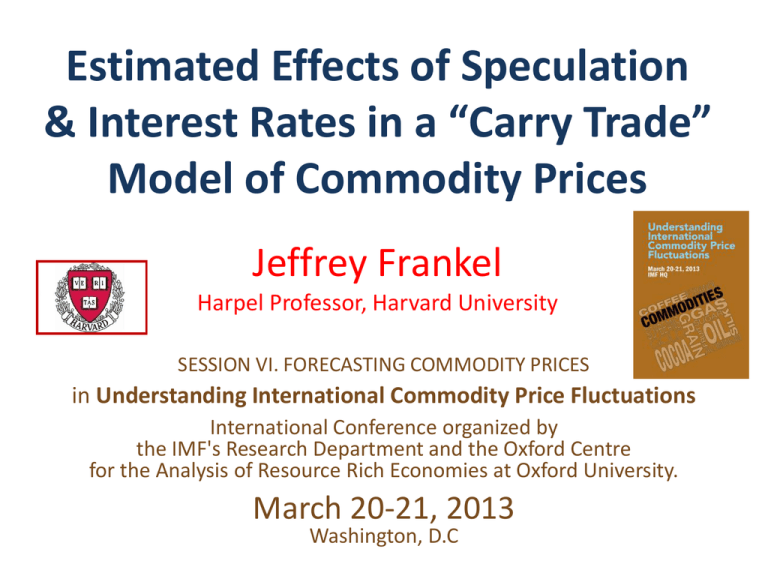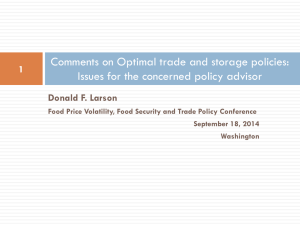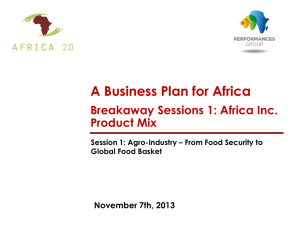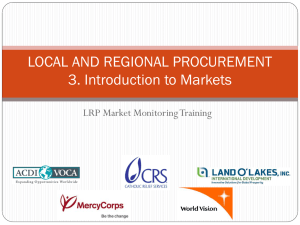c - Harvard University
advertisement

Estimated Effects of Speculation
& Interest Rates in a “Carry Trade”
Model of Commodity Prices
Jeffrey Frankel
Harpel Professor, Harvard University
SESSION VI. FORECASTING COMMODITY PRICES
in Understanding International Commodity Price Fluctuations
International Conference organized by
the IMF's Research Department and the Oxford Centre
for the Analysis of Resource Rich Economies at Oxford University.
March 20-21, 2013
Washington, D.C
Three explanations for big recent increases
in the prices of oil, minerals & agricultural commodities
• (1) global growth
– especially China
• (2) speculation
– defined as purchases of commodities,
in anticipation of gain at the time of resale.
– Includes:
• not only possible destabilizing speculation (bandwagons),
• but also tstabilizing speculation.
• (3) easy monetary policy
– reflected in low real interest rates.
• (4) financialization:
– open position in commodities futures,
• by commodity index funds & other traders
• esp. since 2005
High real interest rates reduce the price of
storable commodities through 4 channels:
• ¤ by increasing the incentive for extraction today
– rather than tomorrow;
– think of rates at which oil is pumped, copper mined, or forests logged.
• ¤ by decreasing firms' desire to carry inventories;
– think of oil inventories held in tanks.
• ¤ by encouraging speculators to shift out of spot
commodity contracts, and into treasury bills,
– the famous “financialization" of commodities
.
• ¤ by appreciating the domestic currency
– and so reducing the price of internationally traded commodities
in domestic terms,
– even if the price hasn't fallen in terms of foreign currency.
Figure 1a: Real commodity price index (Moody’s)
and real interest rates
Figure 1b: Real commodity price index
(Moody’s) and real interest rates
The 2008 spike in commodity prices
• Explanation (1) didn’t fit:
– Growth had already begun to slow by 2008 1st half
– while the commodity price rise accelerated.
• Explanation (4) couldn’t explain a sudden rise in 2008.
• That leaves explanations (2) & (3):
– Speculation & low interest rates.
• But many argued that inventory data belied them:
– if speculators were betting on future price increases,
inventory demand should be high.
– The same if the cause were low interest rates.
– But, it was claimed, inventory levels were not high.
– E.g.. Kohn (2008), Krugman (2008a, b) & Wolf (2008).
When inventories rise, the commodity price falls.
World Economic Outlook,
IMF, April 2012
Literature on oil inventories
• We need systematic study of inventories,
– E.g., Working (1949), Deaton and Laroque (1996), Ye, Zyren & Shore (2002, 05, 06)
– and role of speculation and interest rates.
• Some have found evidence in inventory data
for an important role for speculation,
– driven by geopolitical fears:
• disruption to the supply of Mideastern oil.
– Kilian & Murphy (2013); Kilian & Lee (2013).
• But the speculative factor is inferred implicitly
– rather than measured explicitly.
– The inference may be invalid
• when inventory changes stem from other causes,
• such as convenience yield.
Empirical innovations of this paper
• Relative to past attempts to capture the roles
of speculation or interest rates via inventories:
– How to measure speculation, market expectations
of future commodity price changes?
• Survey data collected by Consensus Forecasts
• from “over 30 of the world's most
prominent commodity forecasters.”
– How to measure perceived risk to commodity availability?
• Volatility implicit in options prices.
1st assumption: regressive expectations
This specification of expectations can be shown to be rational,
in a model of sticky prices and the right value of ϑ. (Frankel, 1986.)
E (Δs) = - θ (q-𝑞 ) + E(Δp).
(2)
+ 2ndassumption:
speculative arbitrage
E(Δs) + c = i,
(3)
where: c ≡ cy – sc – rp.
=>- θ (q-𝑞 )+E(Δp) + c = i
=>q = - (1/θ) (i - E(Δp) – c)
• q is inversely proportionate
to the real interest rate,
– if𝑞 and c are constant.
(4) .
The overshooting model
The overshooting model
q is inversely proportionate to the real interest rate
Regression of real commodity price indices against real interest rate
(1950-2012)
Table 1
VARIABLES
Real interest rate
Constant
Observations
R2
Dependent variable:
log of commodity price index, deflated by US CPI
CRB
index
-0.041***
Goldman
Dow Jones Moody’s
Sachs
Index
index
Index
-0.034*** -0.071** -0.075***
(0.007)
(0.006)
0.900***
0.066***
(0.017)
(0.016)
(0.011)
(0.018)
739
0.04
739
0.04
739
0.25
513
0.18
*** p<0.01
(0.005)
(0.007)
2.533*** 0.732***
(Standard errors in parentheses.)
Derivation of inventory demand equation
E (Δs) + cy – sc – rp = i
or sc = [E (Δs)-i] +cy – rp.
(3)
(7)
3rd assumption: Storage costs rise with the extent
to which inventory holdings strain existing
storage capacity: sc = Φ (INVENTORIES).
Invert:
INVENTORIES = Φ-1 { sc } .
And combine with the arbitrage condition (7):
INVENTORIES = Φ-1 {[E(Δs)-i] +cy – rp}
The Carry trade model
(8)
Table 4 --
Oil Inventory Equation (1995-2011) 58 observations, quarterly
Petroleum stocks
Millions of barrels
Carry trade:
EΔs - i
(3)
0.12*** 0.12***
(0.03)
Actual US IP growth
(0.03)
0.56*** 0.56***
(0.15)
US Industrial Prod. log
Forecast 2-yr IP growth
(4)
-0.674**
(0.318)
(0.15)
0.004***
(0.000)
Constant
7.313***
(0.008)
R2
0.84
(2)
0.02*
0.02*
(0.01)
(0.01)
0.02
0.01
(0.08)
(0.08)
-0.01
0.01
(0.07)
(0.04)
-0.671**
0.003
0.000
(0.318)
(0.146)
(0.146)
0.91***
0.91***
(0.05)
(0.05)
0.004***
0.000
0.000
(0.000)
(0.000)
(0.000)
7.356***
0.653
0.600
(0.316)
(0.392)
(0.481)
0.97
0.97
Oil Stocks lagged log
Trend
(1)
0.84
Complete equation for determination of price
There is no reason for the net convenience yield, c, to be constant.
c ≡ cy – sc – rp (3)
q- = - (1/θ) (i - E(Δp) – c)
(4)
Substituting from (3) into (4),
q = - (1/θ) [i-E(Δp)] + (1/θ) cy - (1/θ) sc - (1/θ) rp
Hypothesized effects:
– Real interest rate: negative
– Convenience yield: positive
• Economic activity
• Risk of disruption
– Storage costs: negative
• sc = Φ (INVENTORIES).
– Risk premium
• Measured directly: [E(Δs)-(f-s)]
• Or as determined by volatility σ: ambiguous
– Measured by actual volatility
– Or option-implied subjective volatility
(5)
Estimation of determination for real prices,
commodity-by-commodity, 1950-2012
Table 2a -- 1st half
Commodity:
Real interest rate
(1)
(2)
Copper
Corn
(3)
(4)
(5)
Cotton Live cattle Live hogs
-0.07*** -0.05* 0.01
-0.05***
-0.04***
(0.02)
(0.03)
(0.01)
(0.02)
(0.01)
-0.46
0.62
0.56
2.26
-2.62**
(0.57)
(0.57)
(0.58)
(1.48)
(1.12)
-0.19***
-0.07
-0.13
1.12
0.42*
(0.06)
(0.17)
(0.12)
(0.78)
(0.24)
Spread, %
0.000
-0.006
-0.001
-0.007***
-0.004***
Future-Spot
(0.002)
(0.003)
(0.001)
(0.002)
(0.001)
Volatility: Std.dev.
3.04***
0.94
0.20
-0.27
-1.02
of log price over past year
(0.72)
(0.91)
(0.53)
(0.78)
(0.61)
Linear trend
-0.00
-0.04**
-0.04*
-0.08*
0.05
(0.02)
(0.02)
(0.02)
(0.04)
(0.03)
16.94
-20.26
-14.94
-81.65
74.87**
(17.29)
(16.54)
(17.29)
(51.77)
(33.00)
50
0.55
51
0.66
51
0.76
32
0.51
39
0.80
Log World GDP
constant 2000US$ ; WDI
Log Inventories
Constant
Observations (annual) †
R2
*** p<0.01, ** p<0.05, * p<0.1 (Robust standard errors in parentheses.)
† Some commodities have shorter sample periods.
Estimation of determination for real prices,
commodity-by-commodity, 1950-2012, continued
Table 2a -- 2 half
Commodity:
Oats
Real interest rate
-0.04**
-0.02
(0.016)
(0.071)
(0.015)
(0.025)
(0.016)
(0.021)
1.56**
-4.42
3.38***
3.63*
0.38
0.33
(0.593)
(4.984)
(0.753)
(2.012)
(0.837)
(0.702)
-0.31**
-2.82
-0.24***
0.01
0.04
-0.45*
(0.13)
(4.43)
(0.03)
(0.11)
(0.09)
(0.24)
Spread, %
-0.015*
-0.002
-0.000
-0.010**
-0.007**
-0.001
Future-Spot
(0.003)
(0.003)
(0.001)
(0.004)
(0.003)
(0.003)
Volatility: Std.dev.
0.91
-0.08
1.10***
5.15***
1.86**
1.81***
of log price over past year
(0.66)
(0.69)
(0.36)
(0.67)
(0.87)
(0.65)
-0.09***
0.17
-0.12***
-0.12*
-0.04
-0.03
(0.03)
(0.14)
(0.03)
(0.06)
(0.03)
(0.02)
-45.54***
156.65
-98.36***
-111.77*
-13.65
-7.09
(16.33)
(142.65)
(22.41)
(60.57)
(24.71)
(20.18)
nd
Log World GDP
(constant 2000 US$);WDI
Log Inventories
Linear trend
Constant
Observations (annual)
R2
(6)
(7)
(8)
Petroleum Platinum
(9)
(10)
(11)
Silver
Soybeans
Wheat
0.08*** -0.02
-0.04** -0.003
50
29
47
44
48
51
0.63
0.34
0.73
0.62
0.71
0.74
*** p<0.01, ** p<0.05, * p<0.1 (Robust standard errors in parentheses.) † Some commodities have shorter sample periods.
A panel across all 11 commodities
offers hope for greater statistical power
Table 3a
(492 annual observations)
Real interest rate
Log World GDP
(constant 2000 US$) WDI
Dependent variable: real commodity prices (log)
(1)
(6)
(7)
-0.02*
-0.03**
0.01
(0.01)
(0.01)
(0.01)
0.01
3.45***
(0.24)
(0.77)
Global Business Cycle
7.22***
(HP-Filtered World GDP)
(1.08)
Quadratic Trend
0.001***
(0.000)
Log Inventories
Future-Spot Spread, %
Volatility: Standard deviation
of log spot price of past year
Linear Trend
Constant
R2
-0.14***
-0.14***
-0.13***
(0.03)
(0.02)
(0.02)
-0.003***
-0.003***
-0.003***
(0.001)
(0.001)
(0.000)
1.81***
1.92***
1.77***
(0.52)
-0.02*
(0.51)
-0.02***
(0.47)
-0.19***
(0.01)
(0.00)
(0.04)
0.01
0.32
-101.90***
(7.01)
(0.23)
(22.93)
0.46
0.49
0.51
Panel across all 11 commodities;
First differences guard against non-stationarity
Table 3b
Δ Real interest rate
Dependent variable: Δ real commodity prices (log)
(1)
(6)
(7)
-0.021
-0.001
-0.029**
(0.013)
(0.006)
(0.012)
Global Business Cycle
6.765***
(HP-Filtered World GDP)
Forecast 2-yr.US GDP growth
(Consensus Forecasts monthly)
(1.035)
8.575***
11.365***
(1.978)
(2.178)
Quadratic trend
0.002***
(0.000)
Δ Log Inventories
-0.004
-0.08
-0.008
(0.061)
(0.0481)
(0.056)
-0.001***
-0.002***
-0.002***
(0.000)
(0.0005)
(0.000)
-0.067
0.192
0.068
(0.184)
(0.213)
(0.208)
0.010***
0.002***
-0.024***
(0.002)
(0.000)
(0.005)
-0.314***
-0.043***
-0.271***
(0.068)
(0.009)
(0.071)
Observations
216
486
216
R2
0.22
0.17
0.27
Δ Future-Spot Spread, %
Δ Volatility: Std.dev. of
log spot price of past year
Linear Trend
Constant
In conclusion…
• The model can accommodate each of the explanations for
recent increases in commodity prices:
economic activity, speculation, and easy monetary policy.
– Based on “carry trade”: arbitrage relationship between
expected price change and costs of carry: interest rate, storage
costs, and convenience yield.
– And on “overshooting”: prices are expected to regress
gradually back to long-run equilibrium
• Specialized data sources:
– Inventory holdings, as a determinant of storage costs;
– Survey data on forecasts,
as a measure of market expectations of future prices;
– Option-implied volatility, as a measure of risk perceptions,
• to supplement actual volatility
Empirical findings
• Support for Carry Trade approach:
– Negative effect of inventory levels on commodity price;
– Negative effect of interest rate
• on inventory demand and so on commodity price;
– Positive effect of expected price increase
• on inventory demand and so on commodity price.
• More specifically, the overshooting model:
– negative effect of real interest rate on real commodity prices.
• Also some (limited) support for other relevant variables:
– economic activity
– forward-spot spread
– volatility.
22
Appendix: Data graphs
Real Moody’s commodity price index
Real interest rate
1950-2012
1995-2012
Petroleum inventories
Risk premium &
(f-s) - E(Δs)
2 measures of volatility
option-implied and actual volatilities
The disappearance of the positive risk premium after 2005
(EΔs measured by survey data) and with no obvious trend in volatility
is consistent with Hamilton &Wu’s (2013) interpretation of the financialization hypothesis:
Investors in commodity indices took the long side of the futures market after 2005.
Spot prices of individual commodities
with forward-spot spread
Minerals
Spot prices of individual commodities
with forward-spot spread
Food crops
Spot prices of individual commodities
with forward-spot spread
Other agricultural









